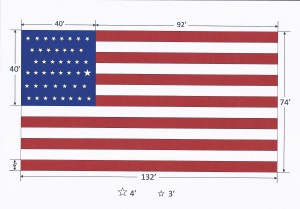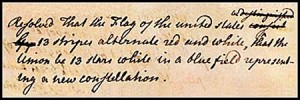Flag Day 2013
Americans celebrated last Friday, June 14th as Flag Day to honor the United States flag’s 236th birthday. The flag’s birth certificate—a resolution of the Continental Congress adopted on June 14, 1777—reads, “Resolved, That the flag of the thirteen United States be thirteen stripes, alternate red and white; that the union be thirteen stars, white in a blue field, representing a new constellation.” Today the Union of stars has grown to fifty as the flag has grown in its meaning to symbolize the shared traditions, values and aspirations of more than 300 million Americans.
Colonial Flag Company and Challenger School’s Headquarters celebrated Flag Day by raising two big flags on two tall poles and continued a Utah tradition going back before the arrival of the pioneers. While yet underway west, Brigham Young considered raising flags in the Valley of the Great Salt Lake. Amid large mountains, Young reasoned flags measuring eight by sixteen feet would not be visible, and he concluded that a flag of thirty by ninety feet would be better.

Twin Mammoth Flags fly at Colonial Flag Company and the Challenger School Headquarters at 9400 South in Sandy, Utah.
At the first Pioneer Day Celebration held in 1849, the pioneers raised a flag sixty five feet long on a pole measuring one hundred and four feet tall, and the following year they raised an even bigger flag measuring thirty by eighty feet. These and other early large flags were christened mammoth flags, and they did show these men and women had a big interest in flags or perhaps better said an interest in big flags.
After almost fifty years, Utah was finally admitted to the Union in 1896, and to celebrate the citizenry made another mammoth flag. This time the flag measured a gigantic seventy-four by one hundred and thirty-two feet, too large for even the largest available flagpole. With stripes six feet wide and a Union of forty-five stars measuring forty feet square, this Stars and Stripes was at the time the largest flag in the world. It covered the ceiling of the Salt Lake Tabernacle stretching from the massive organ pipes on the west of the building all the way to the balcony above the east entrances. A year and a half later, this mammoth statehood flag was reused to celebrate the fiftieth anniversary of the pioneer’s arrival on the shores of the Great Salt Lake. Still too big for any pole, it was hung to cover the south wall of the Salt Lake Temple. Stretching from the towers on the east to the towers on the west the huge flag had to be draped slightly to fit.

The dimensions of the gigantic Forty-five Star Flag made for Utah’s Admission to the Union in 1896 are shown on this chart.
What of the tradition of the Mammoth Statehood flag? Colonial Flag has also continued this tradition of gigantic flags by sewing flags measuring one hundred and fifty feet by three hundred feet. Flags too large for the ceiling of the Tabernacle and also too large to be hung on the south wall of the Salt Lake Temple, but just the right size to cover an entire football field. On the tenth anniversary of the 9/11 terrorist attacks, all NFL football games began with the display of these stadium size flags in six football stadiums around the country. All six of these flags were sewn right here in Sandy.
Colonial Flag Company therefore continues and adds to Utah’s tradition, and Challenger School with its new tall pole and big flag joins in advancing the tradition. Barbara Baker, Challenger School’s late founder, had a love for large flags flying on tall flagpoles. She wanted a pole and flag as big as Colonial’s, or if possible bigger. “Challenger school proudly displays the flag of the United States of America,” explains Challenger CEO , Hugh Gourgeon, “because it is the symbol of the first and only republic founded upon the principle that the sole just purpose of government is the protection of individual rights.”
Two tall poles—each one a hundred and ten feet high—and two mammoth flags—thirty by sixty feet. Challenger School and Colonial Flag joined together to celebrate Flag Day and to continue the Utah Tradition of tall poles and big flags.

